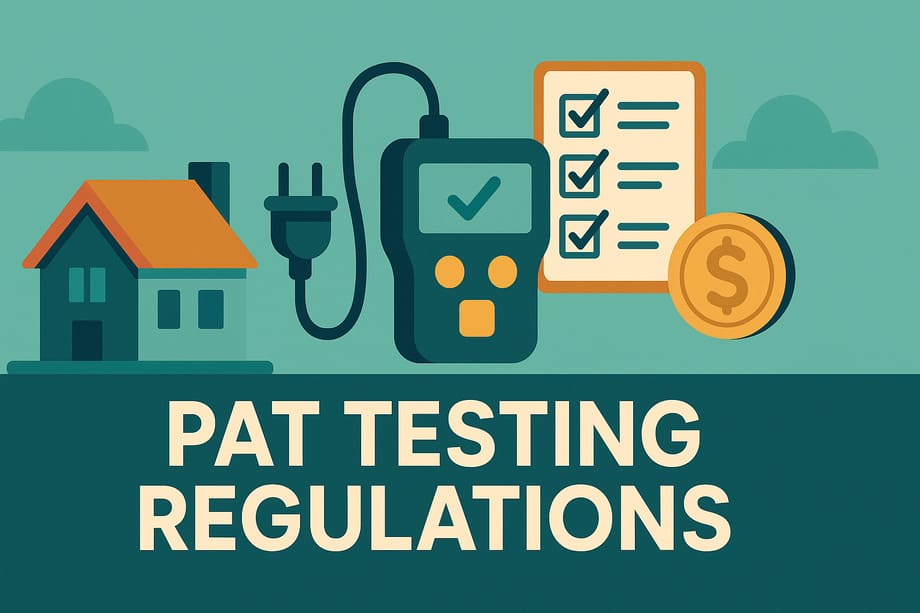PAT Testing Regulations UK – What You Need to Know

When it comes to electrical safety in the workplace, PAT testing is one of the most important considerations for UK businesses and landlords. But what are the actual legal requirements for PAT testing, and do you really need to comply?
Understanding PAT testing regulations can be confusing because there’s no specific law that says “you must do PAT testing.” However, several pieces of UK legislation create legal obligations that make PAT testing the most practical way to ensure compliance and keep people safe.
Whether you’re an employer, landlord, or self-employed, this guide explains everything you need to know about PAT testing regulations and your legal obligations in 2025.
What is PAT Testing?
PAT testing stands for Portable Appliance Testing. It’s the process of checking electrical appliances and equipment to make sure they’re safe to use.
A PAT test involves:
- Visual inspection: Looking for obvious damage like frayed cables or broken plugs
- Electrical testing: Using special equipment to test things like insulation and earthing
- Documentation: Recording the results and labeling equipment as passed or failed
The goal is to identify potential electrical hazards before they cause accidents, fires, or electric shocks.
What Equipment Needs PAT Testing?
According to the HSE, portable electrical equipment includes anything that can be moved while connected to or disconnected from the electrical supply.
This typically includes:
Small Portable Items:
- Kettles and toasters
- Vacuum cleaners
- Desk lamps and fans
- Hair dryers
- Portable heaters
- Phone chargers
Larger Equipment:
- Desktop computers
- Printers and photocopiers
- Microwaves
- Refrigerators
- Washing machines
- Vending machines
Other Items:
- Extension leads
- Power tools
- Any equipment with a plug and cable
Generally, if it has a plug and lead, it should be considered for PAT testing.
Is PAT Testing a Legal Requirement?
The Short Answer
PAT testing is not specifically required by law. There’s no UK law that explicitly says “you must do PAT testing.”
However, several laws create legal obligations that PAT testing helps you meet:
The Legal Framework
Health and Safety at Work Act 1974 Employers must ensure the health, safety, and welfare of employees. This includes keeping electrical equipment safe.
Electricity at Work Regulations 1989 These regulations require that electrical equipment that could cause injury must be maintained in a safe condition.
Provision and Use of Work Equipment Regulations 1998 Work equipment, including portable appliances, must be kept in safe working order.
Management of Health and Safety at Work Regulations 1999 Employers must assess risks and take appropriate safety measures.
Why PAT Testing Became Standard Practice
Although not legally mandated, PAT testing has become the accepted way to comply with electrical safety laws because:
- It provides systematic electrical safety checks
- It creates documented proof of your safety efforts
- The HSE recognizes it as good practice
- Insurance companies often expect it
- It helps protect you from legal liability
Who Needs to Follow PAT Testing Regulations?
Employers and Businesses
All employers have legal duties to ensure electrical safety under the Health and Safety at Work Act and Electricity at Work Regulations.
This applies to:
- Offices and shops
- Restaurants and cafes
- Factories and warehouses
- Schools and colleges
- Healthcare facilities
- Any workplace with electrical equipment
Landlords
Landlords have specific electrical safety obligations:
Under the Landlord and Tenant Act 1985:
- Electrical equipment provided to tenants must be safe
- Equipment must be maintained throughout the tenancy
When PAT Testing May Be Required:
- Property license conditions often include PAT testing requirements
- HMO licenses frequently require electrical safety measures
- Some local authorities mandate PAT testing for rental properties
Self-Employed Workers
Even if you work alone, you may have electrical safety obligations if your work could affect others or if you occasionally employ people.
How Often Should PAT Testing Be Done?
There are no fixed legal requirements for testing frequency. The HSE recommends a risk-based approach considering:
- Type of equipment
- Environment where it’s used
- How often it’s used
PAT Testing Frequency Guide
The table below shows recommended testing intervals based on HSE guidance and industry best practice:
Office Environments (Low Risk)
| Equipment Type | Visual Inspection | Combined Inspection & Test |
|---|---|---|
| Desktop computers | 6 months | 4 years |
| Laptops and tablets | 6 months | 2 years |
| Printers and copiers | 6 months | 2 years |
| Desk lamps | 6 months | 2 years |
| Kettles and small appliances | 6 months | 12 months |
| Extension leads (light use) | 6 months | 2 years |
Industrial Settings (Medium Risk)
| Equipment Type | Visual Inspection | Combined Inspection & Test |
|---|---|---|
| Portable power tools | 1 month | 6 months |
| Handheld equipment | 1 month | 6 months |
| Extension leads | 1 month | 6 months |
| Stationary equipment | 6 months | 12 months |
| IT equipment | 6 months | 12 months |
Construction Sites (High Risk)
| Equipment Type | Visual Inspection | Combined Inspection & Test |
|---|---|---|
| Portable power tools | Weekly | 3 months |
| Extension leads | Weekly | 3 months |
| Portable lights | Weekly | 3 months |
| 110V equipment | Weekly | 3 months |
| Battery chargers | 1 month | 6 months |
Educational Settings
| Equipment Type | Visual Inspection | Combined Inspection & Test |
|---|---|---|
| IT equipment (classrooms) | 6 months | 2 years |
| Science lab equipment | 3 months | 6 months |
| Workshop tools | 1 month | 6 months |
| Cleaning equipment | 3 months | 12 months |
| Staff room appliances | 6 months | 12 months |
Healthcare Facilities
| Equipment Type | Visual Inspection | Combined Inspection & Test |
|---|---|---|
| Non-medical portable equipment | 3 months | 6 months |
| Cleaning equipment | 3 months | 6 months |
| Office equipment | 6 months | 12 months |
| Extension leads | 3 months | 6 months |
| Kitchen appliances | 6 months | 12 months |
Hotels and Hospitality
| Equipment Type | Visual Inspection | Combined Inspection & Test |
|---|---|---|
| Room appliances (irons, hair dryers) | 3 months | 6 months |
| Kitchen equipment | 3 months | 6 months |
| Cleaning equipment | 3 months | 6 months |
| Office equipment | 6 months | 12 months |
| Extension leads | 3 months | 6 months |
Rental Properties
| Equipment Type | Visual Inspection | Combined Inspection & Test |
|---|---|---|
| Kitchen appliances | Before each tenancy | 12 months |
| Portable heaters | Before each tenancy | 12 months |
| Extension leads | Before each tenancy | 12 months |
| Entertainment equipment | Before each tenancy | 2 years |
Factors That May Increase Testing Frequency
Equipment Condition:
- Older equipment may need more frequent testing
- Previously failed equipment should be monitored more closely
- Equipment showing signs of wear
Usage Patterns:
- Heavily used equipment needs more frequent testing
- Equipment used by multiple people
- Equipment moved frequently
Environmental Factors:
- Dusty or dirty environments
- Damp or humid conditions
- Extreme temperatures
- Exposure to vibration or shock
User Supervision:
- Equipment used by untrained users
- Public access equipment
- Equipment used without supervision
Creating Your Testing Schedule
Step 1: Equipment Inventory
- List all portable electrical equipment
- Note equipment type and usage
- Identify high-risk items
Step 2: Risk Assessment
- Assess environment and usage
- Consider user competence
- Identify potential hazards
Step 3: Set Testing Frequencies
- Use the tables above as starting points
- Adjust based on your specific risks
- Document your decisions
Step 4: Plan Testing Schedule
- Spread testing throughout the year
- Consider operational requirements
- Plan for equipment downtime
The key is to assess the risks and set appropriate intervals for your situation.
Who Can Do PAT Testing?
The “Competent Person” Rule
PAT testing can be done by any “competent person” – you don’t need to be a qualified electrician.
According to the HSE, a competent person is someone with enough knowledge and experience to:
- Recognize electrical hazards
- Know what a properly wired plug looks like
- Use PAT testing equipment correctly
- Understand test results
Training Requirements
While formal qualifications aren’t legally required, proper training is essential:
For Visual Inspections:
- Basic electrical safety knowledge
- Ability to spot obvious damage
For Electrical Testing:
- Understanding of PAT testing equipment
- Knowledge of electrical testing principles
- Ability to interpret results
Training Options:
- City & Guilds PAT testing courses
- Commercial training providers
- Online training programs
Many businesses choose to train their own staff or hire professional PAT testing contractors.
How to Do PAT Testing
Step 1: Visual Inspection
Check each appliance for:
- Damage to the plug (bent pins, cracks)
- Frayed or cut cables
- Signs of overheating (burn marks, melted plastic)
- Loose connections
- Damaged casing
Step 2: Electrical Testing
Using PAT testing equipment, perform:
- Earth continuity test: Checks protective connections
- Insulation resistance test: Tests insulation quality
- Polarity test: Ensures correct wiring
Step 3: Record Results
- Document all test results
- Apply pass/fail labels to equipment
- Schedule next test dates
- Keep records for compliance and insurance
What Happens if Equipment Fails PAT Testing?
Immediate Action Required
Remove from Use:
- Disconnect failed equipment immediately
- Apply “DO NOT USE” labels
- Prevent others from using it
Next Steps
Assess the Problem:
- Determine if repair is worthwhile
- Consider replacement for older equipment
- Get professional repair quotes
Professional Repair:
- Use qualified repair services
- Ensure repairs meet safety standards
- Retest equipment after repair
Safe Disposal:
- Dispose of unrepairable equipment properly
- Follow electrical waste regulations
- Update equipment records
Consequences of Non-Compliance
Legal Action
Health and Safety Executive:
- Improvement notices
- Prohibition notices
- Prosecution for safety breaches
- Fines up to £20,000 or unlimited in crown court
Other Consequences
Insurance Issues:
- Claims may be rejected
- Higher premiums for poor safety records
Civil Liability:
- Personal injury compensation claims
- Property damage costs
- Business interruption losses
Real Examples: Businesses have been prosecuted and fined when electrical accidents occurred and they couldn’t demonstrate proper equipment maintenance.
PAT Testing for Different Types of Businesses
Office-Based Businesses
Lower Risk Environment:
- Less frequent testing required
- Focus on regularly used equipment
- Visual inspections often sufficient between formal tests
Industrial and Manufacturing
Higher Risk:
- More frequent testing needed
- Harsh environments increase equipment wear
- Specialist equipment may need expert testing
Construction Sites
Highest Risk:
- Equipment exposed to harsh conditions
- Testing every 3 months recommended
- Daily visual checks essential
Rental Properties
Landlord Responsibilities:
- PAT test appliances provided to tenants
- May be required by licensing conditions
- Good practice for insurance compliance
Practical Tips for Compliance
Getting Started
Equipment Inventory:
- List all portable electrical equipment
- Note locations and usage patterns
- Assess risk levels
Choose Your Approach:
- Train staff and buy equipment (£200-2000 initial cost)
- Hire contractors (typically £1-3 per item)
- Combination of both approaches
Keeping Records
What to Record:
- Equipment details and location
- Test dates and results
- Next test due dates
- Any defects found and actions taken
Why Records Matter:
- Legal compliance evidence
- Insurance requirements
- Planning future tests
- Tracking equipment history
Cost-Effective Compliance
Money-Saving Tips:
- Combine with other electrical safety checks
- Train multiple staff members
- Bulk purchase PAT testing equipment
- Regular maintenance reduces failures
Common PAT Testing Myths
Myth: “PAT testing is legally required”
Reality: No specific law requires PAT testing, but electrical safety laws create obligations that PAT testing helps meet.
Myth: “Only electricians can do PAT testing”
Reality: Any competent person with proper training can perform PAT testing.
Myth: “All equipment needs annual testing”
Reality: Testing frequency should be based on risk assessment, not arbitrary timescales.
Myth: “New equipment doesn’t need testing”
Reality: While new equipment should be safe, visual inspection is recommended, and it should enter your testing schedule.
Myth: “PAT testing guarantees safety”
Reality: PAT testing is part of overall electrical safety management, not a complete solution.
When to Get Professional Help
Consider Professional Services When:
- You have complex or specialized equipment
- Your staff lack the necessary knowledge
- You want guaranteed compliance
- Insurance requires professional certification
- You have limited time for training and testing
Choosing a PAT Testing Company
What to Look For:
- Proper insurance and qualifications
- Experience in your industry
- Clear pricing structure
- Good references from similar businesses
- Comprehensive reporting and documentation
Conclusion
PAT testing regulations in the UK aren’t about specific PAT testing laws – they’re about broader electrical safety obligations that affect all employers and many landlords. While PAT testing isn’t explicitly required by law, it’s become the standard way to demonstrate compliance with electrical safety regulations.
The key points to remember:
- No specific PAT testing law exists, but electrical safety laws create obligations
- Risk assessment determines testing frequency, not arbitrary rules
- Any competent person can do PAT testing with proper training
- Good records are essential for compliance and insurance
- Failed equipment must be removed from service immediately
Whether you choose to do PAT testing in-house or hire contractors, the important thing is to have a systematic approach to electrical safety that protects people and demonstrates your commitment to compliance.
Remember, electrical safety isn’t just about avoiding prosecution – it’s about preventing accidents that could seriously injure or kill someone. PAT testing is a simple, practical way to identify problems before they become dangerous.
If you’re unsure about your specific obligations, consider consulting with electrical safety professionals who can help you develop an appropriate testing program for your business or properties.
Last Updated on August 26, 2025 by James Cartwright







